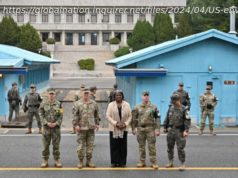Array
The heavens far above the stratosphere may be the battleground in “Star Wars” against North Korea’s vaunted hypersonic cruise missiles. The U.S. Forces Korea command showed off its highest-flying answer to attacks from the North while U.S. and South Korean forces last weekend were winding up their first full-scale joint war games in six years.
The exercise of “Terminal High Altitude Area Defense,” known by the acronym THAAD, fortified the U.S.-South Korean alliance at a time when North Korea is escalating its missile tests and loudly rejecting calls to give up its nukes. More than ever, North Korean leader Kim Jong Un is investing resources into fabricating more warheads while his people, beyond his own elite circle, sink deeper into poverty and hunger reminiscent of the famine of the 1990s in which an estimated 2 million died from hunger and disease.
In never-ending trials of military strength on the Korean peninsula, the display on the THAAD base on a former golf course located 150 miles south of Seoul leaves no doubt that one decisive factor in a second Korean war will be who has the sharpest, strongest missiles — and the ability to shoot them down. Primed for targeting enemy missiles within 125 miles at altitudes of more than 90 miles, THAAD is intended for the defense of the southern tier of South Korea, including the sprawling port complex of Busan and nearby nuclear power plants.
Nobody’s openly suggesting another THAAD base, but American and South Korean commanders eventually may call for a second THAAD facility closer to the line with the North. As of now, Patriot missiles, with far shorter ranges, defend Seoul, the port city of Incheon and the huge base at Camp Humphreys, 40 miles south of the capital, headquarters for the 28,500 U.S. troops in South Korea.
For sure, commanders must anticipate “Star Wars.” That’s why the U.S. Space Force, established several years ago as a separate branch of the armed forces, has stationed its first overseas unit at Osan Air Base near Camp Humphreys.






